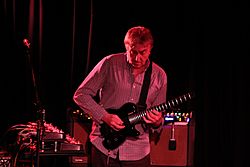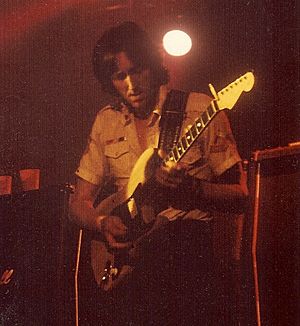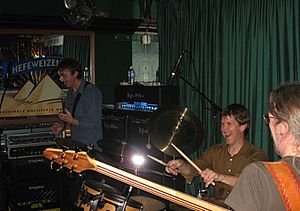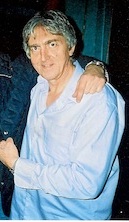Allan Holdsworth facts for kids
Quick facts for kids
Allan Holdsworth
|
|
|---|---|

Holdsworth in 2012
|
|
| Background information | |
| Born | 6 August 1946 Bradford, England |
| Died | 15 April 2017 (aged 70) Vista, California, US |
| Genres |
|
| Occupation(s) |
|
| Instruments |
|
| Years active | 1969–2017 |
| Labels |
|
| Associated acts |
|
Allan Holdsworth (born August 6, 1946 – died April 15, 2017) was a talented British guitarist and composer. He was known for playing jazz fusion and progressive rock music.
Allan had a very special way of playing the guitar. He used advanced music ideas to create unique melodies and chords. His guitar solos were often complex and sounded very smooth, almost like a saxophone. This smooth style, called legato, came from his wish to play the saxophone when he was younger. Since he couldn't afford one, he made his guitar sound like it.
He also became famous for using a special instrument called the SynthAxe in the 1980s. Many famous guitarists, like Eddie Van Halen and Joe Satriani, looked up to Allan Holdsworth. Even Frank Zappa called him "one of the most interesting guys on guitar on the planet."
Contents
Early life
Allan Holdsworth was born in Bradford, England. His grandparents, Sam and Elsie Holdsworth, raised him. His grandfather, Sam, was a jazz pianist. He had tried to be a musician in London before returning to Bradford.
Allan got his first guitar when he was 17 years old. His grandfather taught him how to play music. Allan started his professional music career with the Glen South Band. They played in clubs across Northern England.
Music career
Starting out in the 1970s
Allan Holdsworth made his first recording in 1969 with a band called 'Igginbottom. Their album was named 'Igginbottom's Wrench. In 1971, he joined an improvisational band called Sunship. They played live shows but never released any recorded music.
He then briefly played with the jazz fusion band Nucleus in 1972. He also joined the progressive rock band Tempest for their first album in 1973.
In the mid-1970s, Allan worked with many well-known progressive rock and jazz fusion artists. These included Soft Machine, The Tony Williams Lifetime, Pierre Moerlen's Gong, and Jean-Luc Ponty. He especially enjoyed his time with drummer Tony Williams.
In 1976, Allan was upset when CTI Records released a recording he thought was just a practice session. It was released as an official album called Velvet Darkness. Allan strongly disliked this album and wished it had never been made public.
In 1977, drummer Bill Bruford, who founded the band Yes, asked Allan to play on his first solo album. Soon after, Bruford formed the supergroup U.K. Allan joined them and played on their 1978 album. Even though he liked the people, Allan found touring with U.K. difficult. He didn't like being told how to play his solos.
After leaving U.K., Allan continued to play with Bruford's solo band. He contributed a lot to their 1979 album, One of a Kind. However, Allan wanted to create his own music and soon left the group.
The 1980s
Allan Holdsworth started working with jazz pianist Gordon Beck in 1979. Their first album together was The Things You See in 1980. Soon after, Allan formed his own band called I.O.U. with drummer Gary Husband and bassist Paul Carmichael. They released their first album, I.O.U., in 1982.
After this, guitarist Eddie Van Halen told Warner Bros. Records about Allan. Eddie Van Halen had often praised Allan, calling him "the best" and "number one." This led to Warner Bros. releasing Allan's EP (a shorter album) called Road Games in 1983. It was even nominated for a Grammy Award. However, Allan didn't like Road Games because he disagreed with the producer.
Allan then moved to Southern California. He signed with Enigma Records and released Metal Fatigue in 1985. Bassist Jimmy Johnson joined his band around this time. He, along with Gary Husband and drummer Chad Wackerman, became regular members of Allan's touring bands for many years.
In 1986, Allan released Atavachron. This album was important because it was the first time he used the SynthAxe. This unique guitar-like instrument became a key part of his sound. He released another album, Sand, in 1987, which featured more SynthAxe experiments.
In the late 1980s, Allan built his own recording studio called The Brewery. He recorded many of his albums there, starting with Secrets in 1989. This album introduced pianist Steve Hunt, who also played in Allan's touring band.
The 1990s
In 1990, Allan worked with guitarist Frank Gambale on an album called Truth in Shredding. He also played as a guest musician with the band Level 42 in 1990 and on their 1991 album, Guaranteed. Allan also played on Chad Wackerman's first two solo albums.
Allan's first solo album of the 1990s was Wardenclyffe Tower in 1992. He continued to use the SynthAxe on this album. He also started using special baritone guitars designed by Bill DeLap. In 1994, he released Hard Hat Area.
In 1996, Allan collaborated with brothers Anders and Jens Johansson on Heavy Machinery. This album featured a harder guitar sound from Allan. In the same year, he reunited with Gordon Beck for None Too Soon, which included his favorite jazz songs.
2000s until 2017
Allan released The Sixteen Men of Tain in 2000. This was his last album recorded at his studio, The Brewery. After this, he released fewer solo albums due to personal reasons. He did release live albums like All Night Wrong (2002) and Then! (2003). A collection of his best songs, The Best of Allan Holdsworth: Against the Clock, came out in 2005.
His eleventh album, Flat Tire: Music for a Non-Existent Movie, was released in 2001. Allan toured a lot in North America and Europe in the late 2000s. He also played as a guest on albums by other artists. He appeared on keyboardist Derek Sherinian's 2004 album Mythology. He also played with the band Planet X on their 2007 album Quantum.
In 2006, Allan performed with keyboardist Alan Pasqua, Chad Wackerman, and bassist Jimmy Haslip. They played a tribute to the late Tony Williams. A DVD and album of this tour were released. From 2008 to 2010, he toured with drummers Terry Bozzio and Pat Mastelotto, and bassist Tony Levin. They formed a supergroup called HoBoLeMa, playing experimental music.
In 2015, Allan started a project to release new music called Tales from the Vault. This album came out in July 2016.
On April 7, 2017, a box set of Allan's remastered solo albums was released. It was called The Man Who Changed Guitar Forever! The Allan Holdsworth Album Collection. Allan promoted these albums briefly. He sadly passed away a week later, on April 15, 2017, at his home in Vista, California. He was 70 years old. News reports later said he died from high blood pressure. His last concert was in San Diego on April 10, 2017.
Music released after his death
Since Allan's passing, several live albums have been released. These include recordings from jazz festivals and TV broadcasts. Live in Japan 1984 came out in 2018. Warsaw Summer Jazz Days '98 (2019) and Frankfurt '86 (2020) included both CDs and DVDs of his concerts. In 2021, two live albums from the Leverkusen Jazz Festival were released. In 2022, his 2014 performance at the Jarasum International Jazz Festival in Korea was released.
Allan also appeared on two songs on German artist MSM Schmidt's 2017 album "Life." These were his last studio recordings. He also played on the song "Dognose" from Peter Lemer's 2019 album "Jet Yellow," which was recorded in 1977.
His music style
Allan Holdsworth's own songs were mostly instrumental, meaning they didn't have singing. However, his albums from the 1980s often featured singers like Paul Williams and Rowanne Mark. Early in his career, he sometimes played violin and acoustic guitar. He felt he wasn't good at acoustic guitar because its sound didn't suit his smooth, legato playing style.
Allan's guitar style mixed elements of jazz and progressive rock. He used many different musical scales, including unusual ones. In his instructional videos, he showed how he used complex scales and chords.
In his solos, he used fast legato techniques. These included slides, hammer-ons, and pull-offs. These techniques made his playing sound very fluid and smooth. He wanted the sound between picked notes and legato notes to be impossible to tell apart.
Another unique part of his playing was his rich, fingerpicked chords. He often used effects like delay and chorus. He also used volume swells to make his guitar sound like a horn or saxophone. Allan said he preferred the saxophone to the guitar. He tried to make his guitar sound like a saxophone, which led him to develop his unique legato style. He was greatly influenced by saxophonists like John Coltrane and Charlie Parker. Some of his favorite guitarists included Django Reinhardt and Wes Montgomery.
Equipment
Guitars
Allan Holdsworth worked with many guitar makers to find his perfect sound. He felt he never quite achieved it. In the late 1960s and mid-1970s, he mainly used a Gibson SG guitar. Then he switched to custom Fender Stratocaster guitars. These were changed to have different pickups.
In the 1970s, Allan asked guitar makers to create a fretless guitar for him. He wanted to achieve an even smoother sound. However, he found he could get this smooth sound by using the vibrato bar on his regular guitar. This allowed him to change the pitch of notes smoothly, like a saxophone. Because of this, he decided he didn't need a fretless guitar.
In 1984, Allan worked with Ibanez to create his own signature guitars, the AH-10 and AH-20. These guitars had a special semi-hollow body. He also had a signature guitar with Charvel. In 1987, he started a long partnership with Steinberger guitars. These guitars are made from graphite and carbon fiber and don't have a headstock (the top part of the guitar). He helped design the GL2TA-AH model with Ned Steinberger.
In the 1990s, he started playing custom headless guitars made by Bill DeLap. These included a special baritone model with a very long scale length. He also developed signature guitars with Carvin Guitars. These included the semi-hollow H2, the hollow HF2 Fatboy, and the headless HH1 and HH2 models.
On his 1986 album Atavachron, Allan first recorded with the SynthAxe. This was a guitar-like MIDI controller with keys and string triggers. It also had a tube that allowed him to change the sound using his breath. He used synthesizer sounds, mainly from Oberheim synthesizers, with the SynthAxe. He used the SynthAxe on all his solo albums from Atavachron onwards. However, he later said he didn't want it to be such a big part of his playing, especially live. This was because it was very rare and hard to fix.
Amplifiers
Allan Holdsworth was interested in amplifiers from a young age. His father's friend built him his first amplifier.
Over the years, Allan used many different amps. These included the Vox AC30 and Marshall amps. He liked Marshalls for single notes but not for chords because they distorted the sound. He also tried Norlin Lab Series L5 amps, which he found too clean. He also used and supported Pearce amps.
Other amps he used included Johnson amps, Mesa Boogie amps, and a Carvin keyboard amp.
Later in his career, he switched to Hartley-Thompson amps. He thought these amps had a warm and clean sound. Famous guitarist Eddie Van Halen even used Allan's modified Hartley-Thompson amplifier to record his solo on Michael Jackson's song "Beat It" in 1982.
Allan also performed with Yamaha DG80 112 digital modeling amps. He used two of them: one for a clean sound and one for a slightly distorted sound. He also supported Hughes & Kettner amplifiers, using their TriAmp MKII and ZenTera models.
Personal life
Allan Holdsworth lived in California starting in the early 1980s. He loved cycling in his free time. He also enjoyed beer, especially Northern English cask ale. In the 1990s, he even tried brewing his own beer. He invented a special beer pump called The Fizzbuster, which he said made a "beautiful creamy head."
Around 1986, Allan faced financial difficulties. He sometimes had to sell his equipment to make enough money.
Allan became a grandfather in December 2010 when his daughter Louise had a girl named Rori.
Allan Holdsworth passed away on April 15, 2017, at his home in Vista, California. He was 70 years old.
Discography
Solo albums
- Studio
- 1976: Velvet Darkness
- 1982: I.O.U.
- 1983: Road Games (EP)
- 1985: Metal Fatigue
- 1986: Atavachron
- 1987: Sand
- 1989: Secrets
- 1992: Wardenclyffe Tower
- 1993: Hard Hat Area
- 1996: None Too Soon
- 2000: The Sixteen Men of Tain
- 2001: Flat Tire: Music for a Non-Existent Movie
- 2016: Tales from the Vault
- Live
- 1997: I.O.U. Live
- 2002: Live at the Galaxy Theatre (DVD)
- 2002: All Night Wrong
- 2003: Then!
- 2007: Live at Yoshi's (DVD)
- 2018: Live in Japan 1984
- 2019: Warsaw Summer Jazz Days '98 (CD & DVD)
- 2020: Frankfurt '86 (CD & DVD)
- 2021: Leverkusen '97 (CD & DVD)
- 2021: Leverkusen 2010 (CD & DVD)
- 2022: Jarasum Jazz Festival 2014 (CD & DVD)
- Collaborations
- 1980: Conversation Piece – Part 1 & 2, with Gordon Beck, Jeff Clyne and John Stevens
- 1980: The Things You See, with Gordon Beck
- 1988: With a Heart in My Song, with Gordon Beck
- 1990: Truth in Shredding, with Frank Gambale/The Mark Varney Project
- 1996: Heavy Machinery, with Jens Johansson and Anders Johansson
- 2009: Blues for Tony, with Alan Pasqua, Chad Wackerman and Jimmy Haslip (live double album)
- 2009: Propensity, with Danny Thompson and John Stevens (recorded 1978)
- Compilations
- 2005: The Best of Allan Holdsworth: Against the Clock
- 2017: Eidolon: The Allan Holdsworth Collection
- 2017: The Man Who Changed Guitar Forever! The Allan Holdsworth Album Collection (box set)
With other artists
- 'Igginbottom
- 1969: 'Igginbottom's Wrench
- Nucleus
- 1972: Belladonna (released as a solo album by Ian Carr)
- Tempest
- 1973: Tempest
- 2005: Under the Blossom: The Anthology
- Soft Machine
- Studio:
- 1975: Bundles (band member)
- 1981: Land of Cockayne (guest musician)
- 2003: Abracadabra (as Soft Works) (band member)
- Live:
- 2003: BBC Radio 1971–1974
- 2006: Floating World Live 1975
- 2015: Switzerland 1974 (CD, DVD)
- The New Tony Williams Lifetime
- 1975: Believe It
- 1976: Million Dollar Legs
- Pierre Moerlen's Gong
- 1976: Gazeuse!
- 1978: Expresso II
- 1979: Time Is the Key
- John Stevens
- 1977: Touching On
- 1977: Re-Touch
- 1977: Enigmatic Ocean
- 1983: Individual Choice
- 2007: The Atacama Experience
- Bruford
- 1978: Feels Good to Me
- 1979: One of a Kind
- 1986: Master Strokes: 1978–1985 (compilation)
- 2006: Rock Goes to College (CD/DVD, live in 1979)
- U.K.
- 1978: U.K.
- 1999: Concert Classics Volume 4 (live 1978; reissued variously as Live in America and Live in Boston)
- 2016: Ultimate Collector's Edition (box set)
- Gordon Beck
- 1979: Sunbird
- 1980: The Things You See
- Jon St. James
- 1986: Fast Impressions (guest soloist on "Fast Impressions" & "Rainy Taxi")
- Krokus
- 1986: Change of Address (guest soloist on "Long Way From Home")
- 1988: If This Bass Could Only Talk (guest soloist on "Stories to Tell")
- Stuart Hamm
- 1988: Radio Free Albemuth
- 1989: A Question of Time (guest soloist on "Obsession" & "Only Playing Games")
- Alex Masi
- 1989: Attack of the Neon Shark (guest soloist on "Cold Sun")
- Chad Wackerman
- 1991: Forty Reasons
- 1993: The View
- 2012: Dreams Nightmares and Improvisations
- 1991: Guaranteed
- 1996: Stare (guest soloist on "Don't Make Me Stay")
- Steve Hunt
- 1997: From Your Heart and Your Soul
- Steve Tavaglione
- 1997: Blue Tav
- Derek Sherinian
- 2004: Mythology
- K²
- 2005: Book of the Dead
- Corrado Rustici
- 2006: Deconstruction of a Postmodern Musician (guest soloist on "Tantrum to Blind")
- Planet X
- 2007: Quantum
Videos
- 1992: REH Video: Allan Holdsworth (VHS, reissued on DVD in 2007)
Books
- 1987: Reaching for the Uncommon Chord. Hal Leonard Corporation. ISBN: 978-0-634-07002-0.
- 1994: Just for the Curious. Warner Bros.. ISBN: 978-0-7692-2015-4.
- 1997: Melody Chords for Guitar. Centerstream Publications. ISBN: 978-1-57424-051-1.
See also
 In Spanish: Allan Holdsworth para niños
In Spanish: Allan Holdsworth para niños




